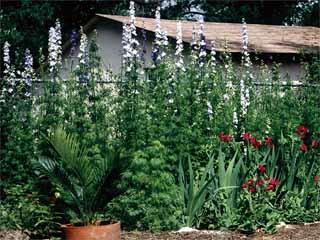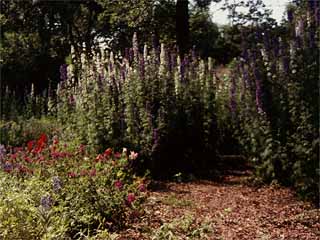Plant Profiles Index > Consolida ambigua
A foolproof plant is the common larkspur...But I have never succeeded with it.
Henry Mitchell on Gardening, p 36.
When I first planted larkspur, I thought I was equally doomed not to succeed with it. Less than ten plants came up and flowered. Why? Because I had planted them in the late spring when it was already too warm for them to germinate. They come up on their own in late fall (to germinate they like cold nights and warm days). I had planted them in semi-shade and they prefer full sun (as they demonstrated by jumping the path into the sun next year). And they really prefer to germinate in mulch (They love coming up in the cedar elm leaves I lay on paths through the meadow).
Larkspur start blooming after the bluebonnets have peaked. Their tall graceful spikes provide a vertical contrast to most of the mounding and spreading wildflowers in the Buffalograss meadow. The unscented flowers can be single or double and colored white, deep purple, pale blue, electric blue, mauve, pale pink, and coral pink, or bicolor. I have selected a double flower that is white with purple edging. Because larkspur self-sows so readily, it tends to crowd itself out. Unthinned, the stalks will grow only 3 feet tall. But if you transplant seedlings into the border about a foot a part, and provide water when the stalks are bolting, you can have plants 5 to 6 feet tall. Larkspur is lime loving, so you can add a little wood ash from the fireplace.
Larkspur is sometimes described as the "poor man's delphinium", a more informal plant better suited for humble cottagers' gardens. It is sometimes treated as the consolation prizes for Southern gardens that are too warm or too limey for delphiniums. I love larkspur for itself, and even if I could grow delphiniums, I would prefer the airy semi-wild larkspur.
 Consolida ambigua 1999-04 Austin, TX
Consolida ambigua 1999-04 Austin, TX
 Consolida ambigua 1998-04 Austin, TX
Consolida ambigua 1998-04 Austin, TX